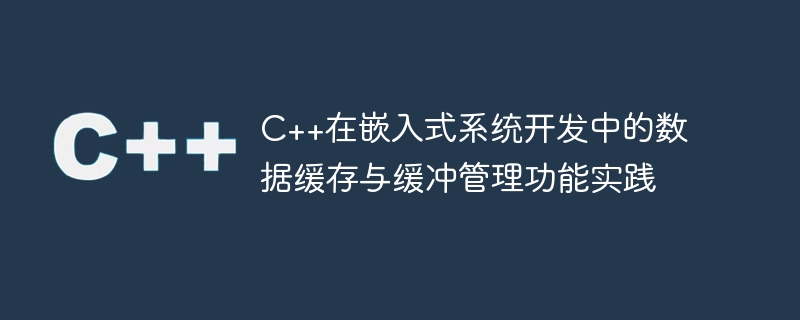

C Practice of data caching and buffer management functions in embedded system development
Introduction: Embedded system is a special computer system, usually used for control , monitor and operate physical equipment. In the development process of embedded systems, data caching and buffer management are very important functions. This article will introduce how to implement data caching and buffer management functions in C, with code examples.
In embedded systems, data caching and buffer management are to improve data access efficiency and reduce the number of accesses to physical devices. By using the caching mechanism, frequently read and written data can be temporarily stored in memory, reducing access delays to underlying devices and improving system response speed. As a language that supports object-oriented programming, C has rich syntax and library functions, which can easily implement data caching and buffer management functions.
In C, you can use container classes to implement data caching. Commonly used container classes include vector, list, map, etc. These container classes provide various operation methods to conveniently store and access data.
The following is a simple example that demonstrates how to use vector to implement an integer data cache:
#include <iostream>
#include <vector>
using namespace std;
class DataCache {
private:
vector<int> cache;
public:
void addData(int data) {
cache.push_back(data);
}
void printCache() {
for (int i = 0; i < cache.size(); i++) {
cout << cache[i] << " ";
}
cout << endl;
}
};
int main() {
DataCache cache;
cache.addData(1);
cache.addData(2);
cache.addData(3);
cache.printCache();
return 0;
}In the above example, the DataCache class uses vector to store integer data. The addData method is used to add data to the cache, and the printCache method is used to print the data in the cache. In the main function, we create a DataCache object cache and add three integer data to it. Finally, use the printCache method to print the data in the cache.
In addition to data caching, embedded systems also need to implement buffer management functions. Buffer management is mainly used to manage buffers, which are temporary areas used to store data.
The following is an example that demonstrates how to use a circular queue (Circular Queue) to implement buffer management:
#include <iostream>
using namespace std;
class BufferManager {
private:
int* buffer;
int front;
int rear;
int size;
public:
BufferManager(int bufferSize) {
buffer = new int[bufferSize];
front = 0;
rear = 0;
size = bufferSize;
}
~BufferManager() {
delete[] buffer;
}
bool isEmpty() {
return front == rear;
}
bool isFull() {
return (rear + 1) % size == front;
}
void push(int data) {
if (isFull()) {
cout << "Buffer is full!" << endl;
} else {
buffer[rear] = data;
rear = (rear + 1) % size;
}
}
void pop() {
if (isEmpty()) {
cout << "Buffer is empty!" << endl;
} else {
front = (front + 1) % size;
}
}
void printBuffer() {
if (isEmpty()) {
cout << "Buffer is empty!" << endl;
} else {
int index = front;
while (index != rear) {
cout << buffer[index] << " ";
index = (index + 1) % size;
}
cout << endl;
}
}
};
int main() {
BufferManager buffer(5);
buffer.push(1);
buffer.push(2);
buffer.push(3);
buffer.push(4);
buffer.push(5);
buffer.printBuffer();
buffer.pop();
buffer.pop();
buffer.printBuffer();
return 0;
}In the above example, the BufferManager class uses a circular queue to manage buffers. The constructor accepts an integer parameter bufferSize, indicating the size of the buffer. The push method is used to add data to the buffer, the pop method is used to remove data from the buffer, and the printBuffer method is used to print the data in the buffer. In the main function, we create a BufferManager object buffer and add five integer data to it. Then use the printBuffer method to print the data in the buffer, and use the pop method to delete the first two data, and finally call the printBuffer method again to print the data in the buffer.
Summary:
This article introduces the method of implementing data caching and buffer management functions in embedded system development in C, and provides relevant code examples. By using container classes and custom data structures, data caching and buffer management functions can be easily implemented to improve the efficiency and response speed of embedded systems. Readers can flexibly use these methods according to their own needs and further expand and optimize code implementation.
The above is the detailed content of Practice of data caching and buffer management functions of C++ in embedded system development. For more information, please follow other related articles on the PHP Chinese website!
 Is linux an embedded system?
Is linux an embedded system?
 What are the differences between c++ and c language
What are the differences between c++ and c language
 Recommended learning order for c++ and python
Recommended learning order for c++ and python
 Cost-effectiveness analysis of learning python and c++
Cost-effectiveness analysis of learning python and c++
 Is c language the same as c++?
Is c language the same as c++?
 Which is better to learn first, c language or c++?
Which is better to learn first, c language or c++?
 The difference and connection between c language and c++
The difference and connection between c language and c++
 C++ software Chinese change tutorial
C++ software Chinese change tutorial




